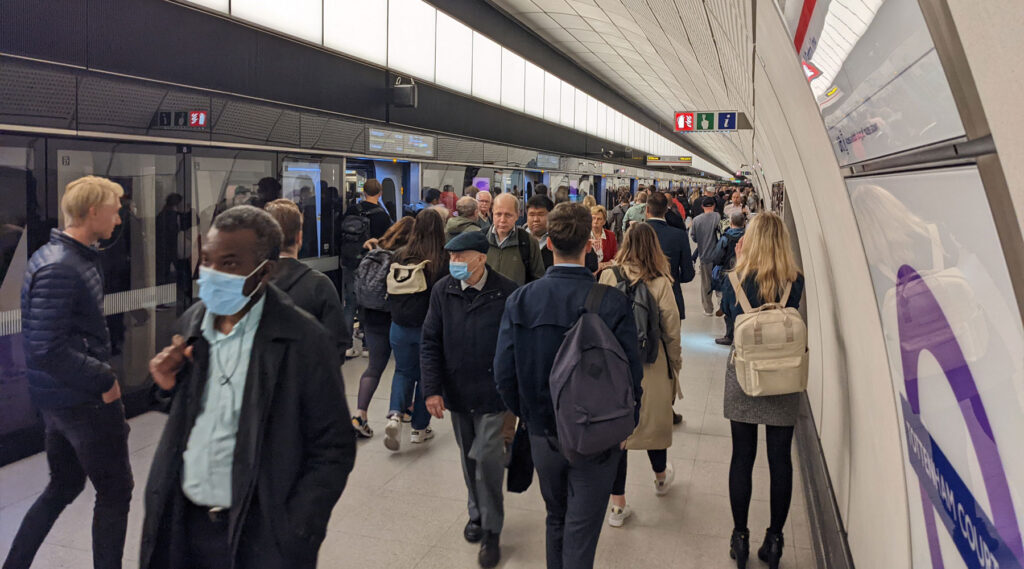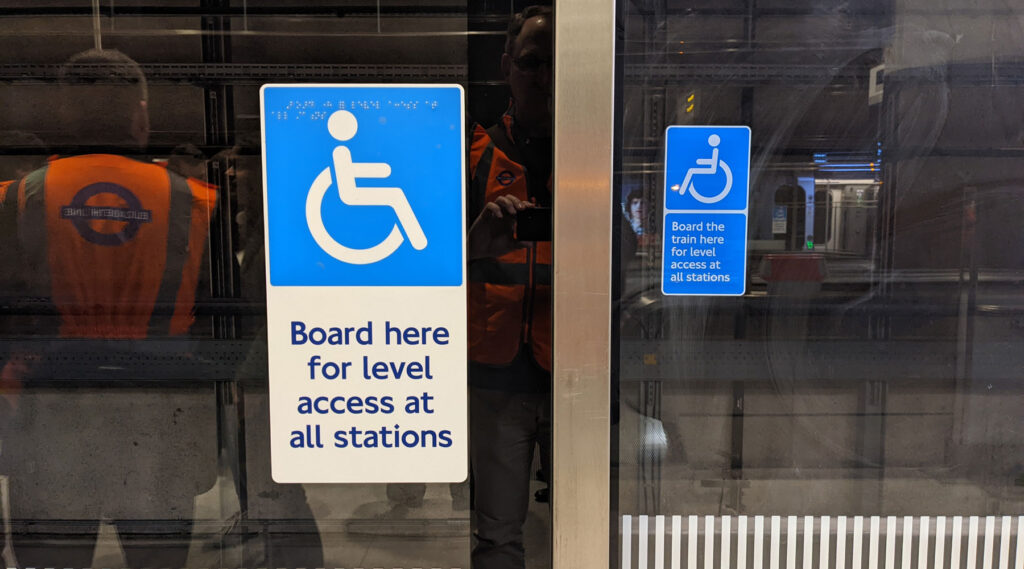On average over 20 million journeys a month are being made on the Elizabeth line, making it the busiest railway in Great Britain according to the latest figures from the transport regulator, the Office of Rail and Road.
For the period Oct to Dec 2022, the report shows that the Elizabeth line recorded 62.2 million passenger journeys. Although that puts it slightly behind Govia Thameslink Railway’s 62.8 million journeys — GTR is made up of four separate railway services (Thameslink, Great Northern, Southern and Gatwick Express).
The figures don’t include Northern Ireland’s NI Railways, but it doesn’t affect the overall findings that London’s newest railway is now the busiest single service in the UK, and a railway that is less than a year old is now carrying one in six of all rail passenger journeys in Great Britain.
People on the western branch have even been complaining that it’s too busy!
This is not unreasonable though as there has been the delay as trains are paused outside Paddington station (to be removed in May), and the service has soaked up a lot of traffic to/from Heathrow Airport, so there’s lot of luggage in the aisles, which can make the trains feel fuller, even if they’re not occupying any more seats.
During the morning rush hour, on the eastern branch from Abbey Wood, it’s not uncommon for the trains to be almost standing room only just one stop along at Woolwich. Anecdotally, Woolwich has seen a huge surge in people using trains to get into town, as the Elizabeth line platforms are far busier than the DLR/Southeastern platforms ever were before the Elizabeth line opened.
Opening the railway has created a demand for public transport, so either lots of people weren’t travelling, or they have switched from cars and buses to the railway. Which reduces road congestion and pollution in London.
And again anecdotally, I have personally seen a noticeable increase in people using wheelchairs at Woolwich’s Elizabeth line station compared to what I used to see on the DLR, so an accessible railway makes it possible for people who struggled to travel to do so.
The railways also reduce congestion by moving far more people in a smaller amount of space. A 6-lane wide urban motorway (such as the A13 in east London or the Westway in West London) can handle 5,600 cars per hour, and with an average occupancy in the UK of 1.66 people per car, that’s just under 10,000 people per hour.
The Elizabeth line can handle around 36,000 passengers per hour at peak rates.
Ultimately, the Elizabeth line shows that investments in public transport work, not just for the people who use the railway, but by making it possible for some drivers to switch away from cars it improves road speeds for those who have no alternative to driving. A win for everyone.
Build it and they will come.
Passenger journeys by operator, Oct to Dec 2022
| Govia Thameslink Railway | 62.8m |
| Elizabeth line | 62.2m |
| London Overground | 38.9m |
| South Western Railway | 34.1m |
| Southeastern | 28.7m |
| Northern Trains | 19.7m |
| Great Western Railway | 18.9m |
| Greater Anglia | 16.6m |
| ScotRail | 15.6m |
| West Midlands Trains | 13.9m |
| c2c | 8.4m |
| CrossCountry | 7.1m |
| Merseyrail | 6.5m |
| Avanti West Coast | 6.2m |
| East Midlands Railway | 6.1m |
| TfW Rail | 5.9m |
| LNER | 5.4m |
| TransPennine Express | 4.9m |
| Chiltern Railways | 4.8m |
| Heathrow Express | 1.1m |
| Grand Central | 0.4m |
| Hull Trains | 0.3m |
| Lumo | 0.2m |
| Caledonian Sleeper | 0.1m |
Across Great Britain, a total of 369 million rail passenger journeys were made during the three months at the end of last year. This is 80% of the 461 million journeys in the same quarter three years ago (pre-pandemic).
Although passenger numbers are rising, they are rising faster than revenues as season ticket sales, which made up the bulk of commuter revenue for the railways before the pandemic are still far below where they used to be.
Season tickets accounted for 15% of journeys made between October and December 2022. This was less than half of the 34% recorded three years ago.
That has a knock-on impact on the railways which will be under pressure to cut costs or raise off-peak fares to make up the difference.
Journey distance has also declined, suggesting shorter local trips which are cheaper — whether that’s due to the cost of fares, or a switch from long distance commuting to local leisure travel is not clear yet from the data.
As a result, total passenger revenue in Great Britain between October to December 2022 was £2.1 billion. This equates to just two-thirds of the £3.2 billion in the same quarter three years ago (when adjusted for inflation).
The recovery in rail traffic continues though.
More recent figures just released by the DfT show that from Friday 10th February, passenger numbers on the national network hit or exceeded 100% five days in a row, and on Wednesday 22nd February 103% was recorded. This means that passenger numbers have doubled in just over a year, with the DfT data showing that since the start of 2023, rail customers have been returning not just on weekends and the middle days of the working week, but also on Mondays and Fridays.
There’s also a suggestion that since March, fares revenue has reached 90% of pre-pandemic levels, but that will take until June to show up in the official reports.
That recovery is occurring even as some rail companies are still struggling to run a reliable service – such as the well publicised problems at Transpennine Express.
The success of the Elizabeth line shows though that investing in the railways to make them reliable, and pleasant to use creates additional demand to use them. That’s a message that the government should take when it’s cutting investment in public transport across the UK and at the same time handing out tax cuts to motorists.









Great article about the success of the Elizabeth Line. Also surprising is just how important and successful is the Thameslink, which does not receive anything like the publicity and accolade of the Elizabeth Line, yet is also doing very well, and in reality is the first “Crossrail” type route in London similar to the RER lines in Paris.
I wonder how many of those complaints about crowding are from people who won’t move down the platforms / trains to where it’s likely there will be more room?
Few weeks ago I did LHR to Farringdon (to connet to Thameslink to brighton) and the end carriages were rammed but plenty of room further along.
I’ve been doing Ealing Broadway to Paddington for decades and been using the new Elizabeth Lines trains for years (at my end they launched pre-pandemic). Moving down the carriage is not the issue. During peak hours they are very overcrowded.
A win for everyone … except people East of Abbey Wood …
Or anywhere else in the country, where our misgovernment seem determined to trash the railways
{ e.g. Proposals to simultaneously cut back HS2 & not extend electrification N of Leicester …… }
I travelled on the Elizabeth line for the first time this week. I was disappointed as the journey did not live up to all the ‘hype’ They are very ordinary overcrowded trains with standing room only and absolutely no provision for passenger’s luggage. The journey from Heathrow to Paddington was very slow with pointless stops at stations such as Southall and Hanwell where hardly anyone got on or off. The journey from Paddington to Farringdon was impresively fast however and I even got a seat.
If you’re used to the modern trains that have been rolled out across the rest of the UK, then the Elizabeth line trains might not look that amazing, but for Londoners, who have some of the oldest trains in the UK (and on the Bakerloo line, literally the oldest at over 50 years old), the Elizabeth line is a revelation.
The trip to Paddington will be much faster in May when the new timetable starts.
As for “pointless stops’ some of those stations can be busy depending on the time of day and likely taking workers to / from Heathrow to make sure your flight was serviced , catered, fuelled, loaded with baggage etc etc
Sounds like the extra trains due on the timetable in May can’t arrive soon enough!
The Elizabeth line is a true marvel. I used it a lot when in London and it’s mind blowing to go from Canary Wharf to The City in two stops and then onto Soho in another two!
The rise at Woolwivh isn’t just anecdotal, someone has done a FOI request for the eastern stations in the core section for passenger numbers.
https://tfl.gov.uk/corporate/transparency/freedom-of-information/foi-request-detail?referenceId=FOI-3227-2223
How do the passenger numbers on the sections of the line that already existed before Crossrail compare to before?
I’m not surprised at all it’s a successful service, and it’ll be interesting to (in time) see analysis of what lines/modes people use to get to/from Crossrail. Which connections are well used, which aren’t, etc.